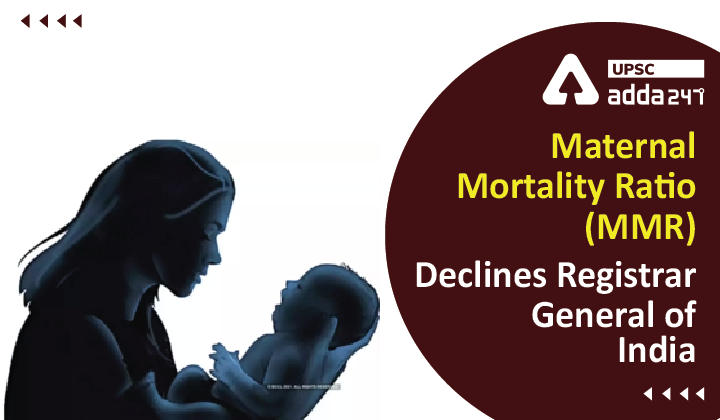Table of Contents
Maternal Mortality Ratio (MMR)- Relevance for UPSC Exam
- GS Paper 2: Governance, Administration and Challenges- Issues relating to development and management of Social Sector/Services relating to Health.
Maternal Mortality Ratio (MMR) in news
- The Maternal Mortality Ratio (MMR) of India has declined by 10 points as per a special bulletin released by the Registrar General of India.
Definition of Maternal Mortality Ratio (MMR)
- The maternal mortality ratio (MMR) is defined as the number of maternal deaths during a given time period per 100,000 live births during the same time period.
- MMR depicts the risk of maternal death relative to the number of live births and essentially captures the risk of death in a single pregnancy or a single live birth.
India’s Maternal Mortality Ratio (MMR)
- India’s Maternal Mortality Ratio (MMR) has declined from 113 in 2016-18 to 103 in 2017-19 (8.8 % decline).
- India had been witnessing a progressive reduction in the MMR from 130 in 2014-2016, 122 in 2015-17, 113 in 2016-18, and to 103 in 2017-19.
- Significance: With this persistent decline, India was on the verge of achieving the National Health Policy (NHP) target of 100/lakh live births by 2020.
- India is also on track to achieve the Sustainable Development Goal (SDG) target of 70/ lakh live births by 2030.
Self Help Groups and Eshakti: Definition, Importance, Challenges and Recommendations
State-wise Performance on MMR
- Increase in Number of States achieving SDG targets: The number of states that have achieved the SDG target has now risen from five to seven. These states are-
- Kerala (30),
- Maharashtra (38),
- Telangana (56),
- Tamil Nadu (58),
- Andhra Pradesh (58),
- Jharkhand (61), and
- Gujarat (70)
- Increase in the number of states achieving NHP Targets: There are now nine states that have achieved the MMR target set by the NHP, which include the above seven and Karnataka (83) and Haryana (96).
- Maximum Decline in MMR: Encouraging achievement has been reported by Uttar Pradesh, which has shown the maximum decline of 30 points, followed by Rajasthan (23 points), Bihar (19 points), Punjab (15 points) and Odisha (14 points).
- States showing an Increase in MMR: West Bengal, Haryana, Uttarakhand and Chhattisgarh have shown an increase in the MMR.
- These states would need to reappraise their strategy and intensify efforts to accelerate the MMR decline to achieve the SDG target.
- Percentage-wise MMR decline in States:
- More than 15% Decline in MMR: Kerala, Maharashtra and Uttar Pradesh have shown more than 15% decline in the MMR.
- Between 10-15% decline in MMR: Jharkhand, Rajasthan, Bihar, Punjab, Telangana and Andhra Pradesh have shown a decline between 10-15%.
- Between 5-10% decline in MMR: Madhya Pradesh, Gujarat, Odisha and Karnataka witnessed a decline between 5-10%.
Key Points about Registrar General of India
- About: In 1949, Government established an organization in the Ministry of Home Affairs under Registrar General and ex-Officio Census Commissioner, India.
- The position of Registrar is usually held by a civil servant holding the rank of Joint Secretary.
- Mandate: Registrar General of India mandated to develop a systematic collection of statistics on the size of the population, its growth, etc.
- Key Responsibilities: Registrar General of India arranges, conducts and analyses the results of the demographic surveys of India including Census of India and Linguistic Survey of India.
Pradhan Mantri Matru Vandana Yojana (PMMVY) | Analysing the Performance of PMMVY
Pradhan Mantri Matru Vandana Yojana (PMMVY) | Analysing the Performance of PMMVY





 TSPSC Group 1 Question Paper 2024, Downl...
TSPSC Group 1 Question Paper 2024, Downl...
 TSPSC Group 1 Answer key 2024 Out, Downl...
TSPSC Group 1 Answer key 2024 Out, Downl...
 UPSC Prelims 2024 Question Paper, Downlo...
UPSC Prelims 2024 Question Paper, Downlo...




